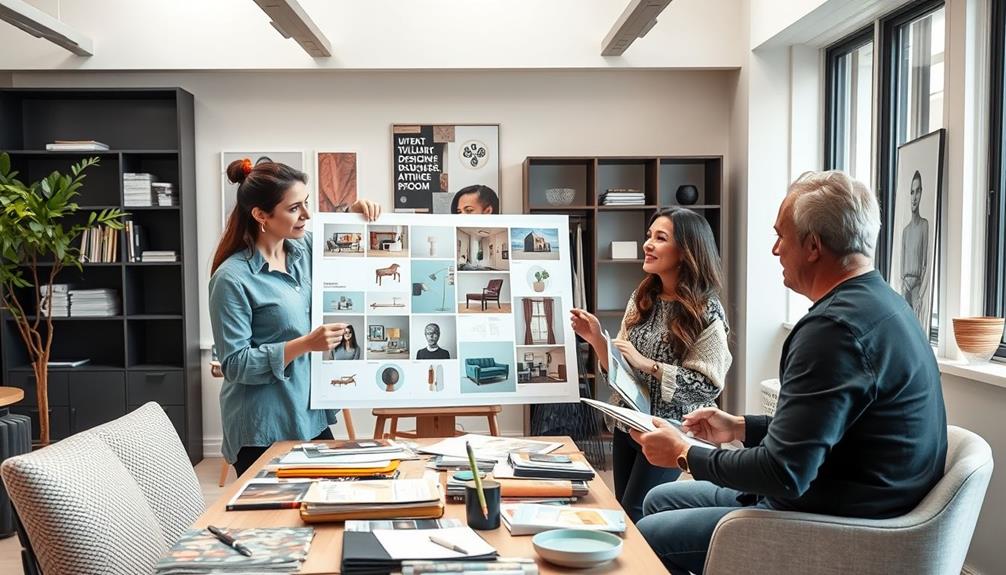To figure out your interior design style, start by reflecting on your aesthetic preferences. Consider colors, textures, and patterns that resonate with you. Create a Pinterest board to gather inspiration and spot recurring themes. Take an online interior design quiz for personalized style insights. Don't forget to analyze past favorites and emotional connections for deeper understanding. Mixing different styles can also bring out your personality, so explore what speaks to you. Each choice creates your unique space, leading you to a cohesive and inviting home. There's more to discover about enhancing your design journey and making it truly yours. Finding your personal design style is an ongoing process that evolves with time. It’s important to stay open to new ideas and inspirations as you refine and develop your aesthetic. Remember that your style can change and grow, so allow yourself the freedom to experiment and explore different looks. By staying true to your authentic self and following your instincts, you’ll continue finding your personal design style and creating a home that reflects your unique personality and taste.
Key Takeaways
- Take an online interior design style quiz to gain personalized insights into your unique aesthetic preferences.
- Create a Pinterest board to visualize and collect decor inspirations, identifying recurring themes and styles.
- Reflect on your favorite items and childhood inspirations to uncover foundational design preferences and emotional connections.
- Analyze the impact of colors and textures in your space, considering how they affect mood and atmosphere.
- Experiment with mixing different design styles while maintaining a unifying theme or color palette for a harmonious look.
Understanding Your Aesthetic Preferences
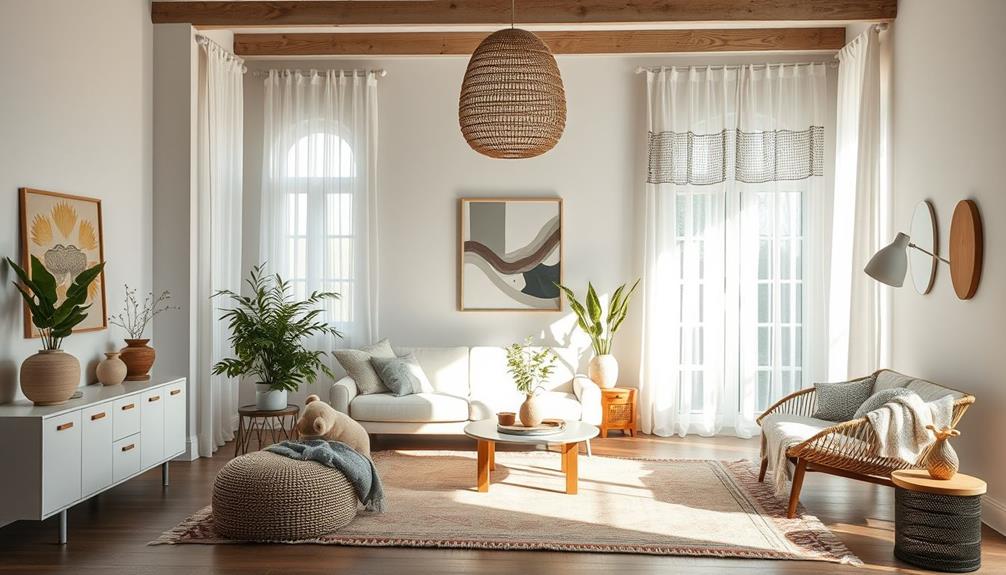
Understanding your aesthetic preferences is essential for creating a space that truly reflects who you are. Start with self-reflection—think about the colors, textures, and patterns that have consistently resonated with you. This isn't just about fleeting trends; it's about discovering your personal style that stands the test of time.
Exploring innovative architectural solutions can also offer insights into how different elements can harmonize within your space.
Use the three-word method to articulate your aesthetic. Isolate descriptive adjectives that capture your style's essence. This simplification helps streamline your design decisions. You might also conduct a self-interview, asking probing questions about your favorite items and the emotions tied to specific spaces. This thorough examination can reveal insights into your unique style.
Create a visual collection, like a Pinterest board, where you gather inspirations that reflect your likes. Look for recurring themes and elements that define your aesthetic.
Taking the Interior Design Style Quiz
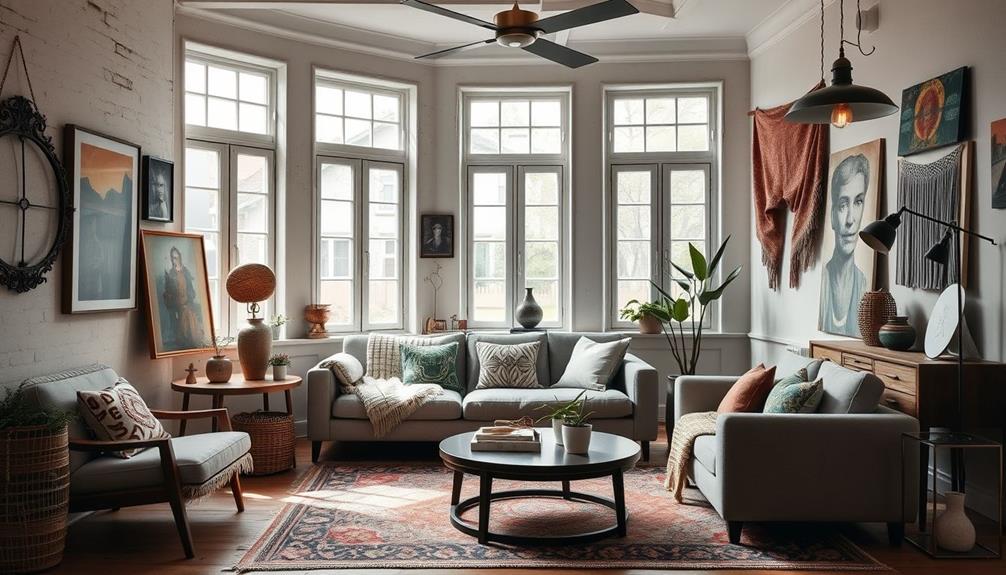
Taking the Interior Design Style Quiz is a great way to discover your unique style.
By answering a few targeted questions, you'll receive personalized design recommendations tailored to your preferences.
This fun quiz simplifies the process of finding the perfect decor to reflect who you are.
Discover Your Unique Style
Finding your unique interior design style can be an exciting journey, and an interior design style quiz is a great way to kick things off. By answering questions about your lifestyle, materials, and color preferences, you'll uncover insights into what resonates with you.
This fun and interactive process helps you discover your unique blend of decor styles, whether you lean towards Bohemian, Glam, or Midcentury Modern. For instance, exploring different styles like Mid-Century Modern Design can inspire you with iconic furniture pieces that blend nostalgia with contemporary flair.
The quiz simplifies the often overwhelming task of defining your personal aesthetic. It provides clarity on how to create a cohesive and meaningful atmosphere in your home. You might find that you embody a mix of several styles, allowing for a more flexible approach to decorating your space.
Once you complete the quiz, you'll receive personalized insights into your style archetype. This knowledge can guide you in selecting furniture and decor that truly reflects who you are.
Personalized Design Recommendations Await
Ready to reveal the secrets of your personal design style? Taking the Interior Design Style Quiz is your first step toward personalized design recommendations tailored just for you.
This engaging quiz dives into your lifestyle, materials, and color preferences, helping you find your design with precision. You might even discover that your aesthetic leans towards the modern farmhouse trend, characterized by neutral color palettes and natural materials.
As you answer the questions, you'll discover insights into your unique style archetype. Once you finish the quiz, you'll receive quiz results that not only guide your choice of furniture and decor but also show how to blend various aesthetics for a cohesive look.
What's even better? You get connected with designers who align with your identified style.
These professionals are ready to provide guidance tailored to your tastes, making your interior design journey smoother and more enjoyable.
Analyzing Popular Design Trends
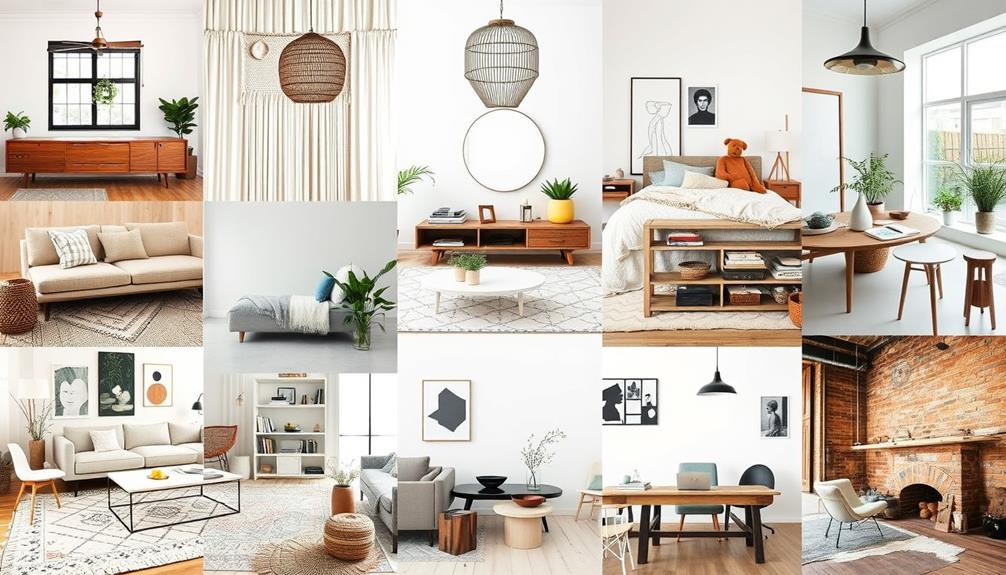
When looking at popular design trends, it's clear they often arise from cultural shifts and the desire for personal expression. Styles like Bohemian and Minimalism showcase how individual tastes shape home decor style, reflecting a need for both vibrancy and simplicity.
Social media platforms like Instagram and Pinterest play a huge role in this. They let you discover and imitate various aesthetics, though this can lead to fleeting preferences rather than lasting design styles. Additionally, trends like Cottagecore emphasize the importance of nature and tranquility, which resonates with a growing appreciation for serene environments the appeal of natural materials.
To truly analyze these trends, consider breaking them down into three descriptive words. For example, "rustic, romantic, soft" perfectly encapsulates the Cottagecore aesthetic. This method helps you pinpoint elements that resonate with your personal taste.
Additionally, trends like Japandi blend Japanese and Scandinavian aesthetics, emphasizing functionality and organic materials, which highlight a growing preference for sustainable living.
You might also notice the rise of multifunctional furniture, catering to urban dwellers. This reflects ongoing trends toward maximizing space efficiency and adaptability, essential for smaller living environments.
Reflecting on Past Favorites
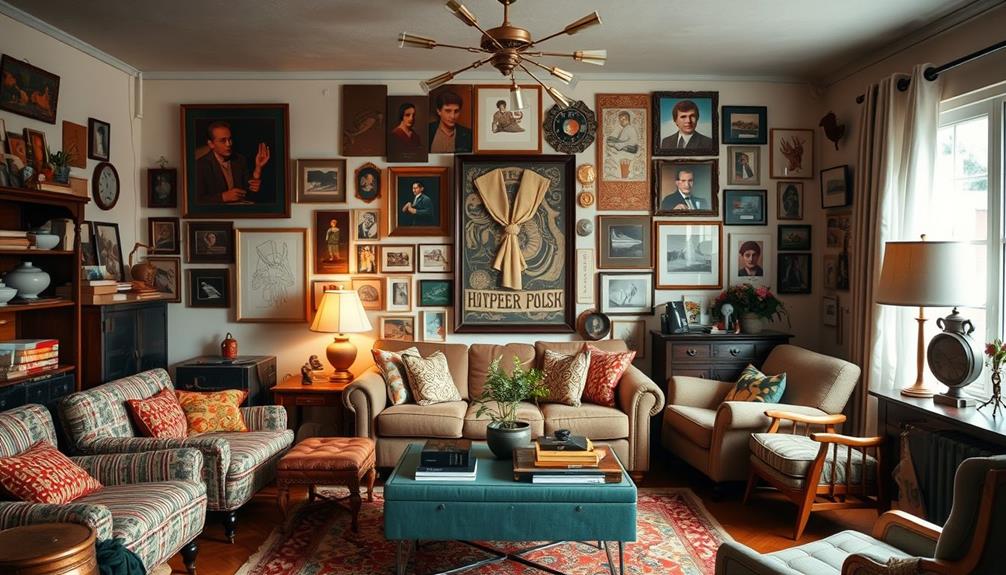
Think back to your childhood inspirations, favorite travel memories, and influential art pieces that have shaped your taste.
These experiences often hold the key to understanding what styles truly resonate with you.
Childhood Inspirations
Reflecting on childhood inspirations can reveal a treasure trove of design preferences that resonate deeply with you. Think back to the decor styles present in your childhood home. Those familiar elements might evoke a sense of comfort and belonging that you want to recreate in the home you love today. The commitment to enhancing spaces reflects the importance of understanding personal history in shaping your design journey.
Consider the beloved colors, patterns, and themes that filled your early years. Were there specific hues that made you feel joyful? Maybe a cozy reading nook filled with your favorite books or a vibrant playroom sparked your imagination. These cherished memories can guide you in selecting design styles that align with your emotional connections.
Take time to analyze your childhood toys, books, or artwork. These items often showcase color palettes and styles that naturally draw you in. You might find that a particular shade or pattern still resonates with you today, waiting to be incorporated into your current space.
Creating a mood board or journaling about these childhood inspirations can clarify which design elements you want to embrace. By reflecting on your past, you'll uncover the unique features that can help shape a home you truly love.
Favorite Travel Memories
Childhood inspirations often lay the groundwork for your design preferences, but favorite travel memories can further illuminate your unique style. Reflecting on past adventures reveals colors, textures, and designs that resonate with specific destinations.
Think about how the warm hues of a sunset in Santorini or the rustic charm of a countryside retreat can influence your home decor.
Consider creating a visual scrapbook or mood board that captures the essence of these beloved places. This can serve as a wellspring of inspiration for your interior design choices.
As you analyze the architectural styles and decor elements from your travels, look for patterns or themes that align with your tastes. Maybe you love the sleek lines of modern design mixed with the warmth of rustic touches—this blend could define your style.
Don't forget to remember the emotions and atmospheres you experienced during your travels. By recreating those feelings in your home, you can achieve a more meaningful design that reflects your journey.
Ultimately, your favorite travel memories can guide your decor decisions and help you craft a space that feels uniquely yours.
Influential Art Pieces
Art holds the power to shape your interior design style, revealing personal aesthetic preferences and recurring themes that resonate deeply with you. Reflecting on your past favorite art pieces can uncover the colors, styles, and mediums that truly define your taste.
Consider how these artworks affect the mood in your spaces. For example:
- Bright, dynamic art suggests a love for lively, eclectic styles.
- Muted, serene pieces may indicate a preference for minimalism or modern aesthetics.
Analyzing where you enjoyed these pieces—like in homes or galleries—can clarify what environments inspire you. Keeping a visual diary or Pinterest board of your favorites tracks evolving tastes.
Engaging in conversations about influential art with friends can also help you discover hidden preferences. Sharing perspectives not only broadens your understanding but may inspire fresh design directions.
Mixing Different Design Styles
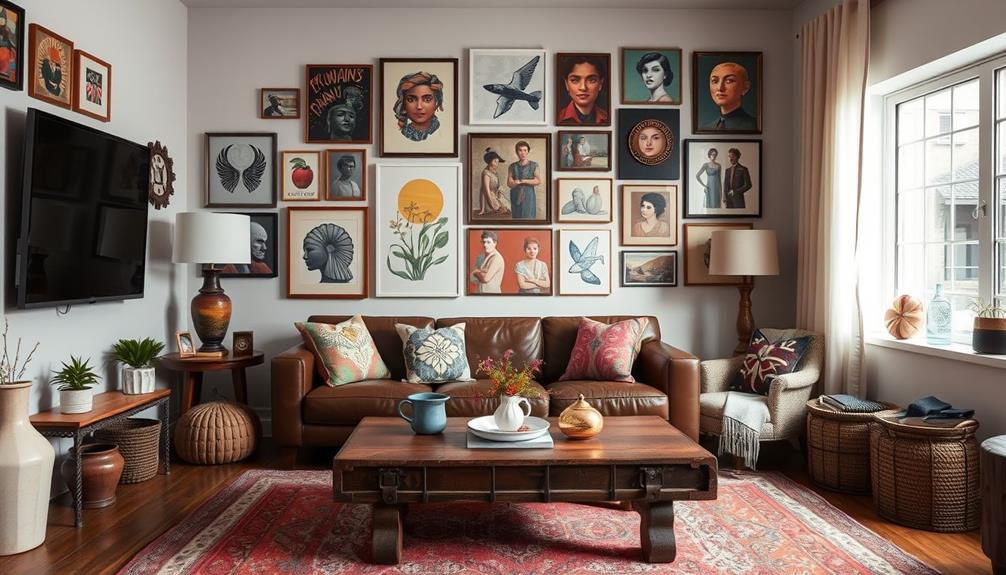
Mixing different design styles allows you to craft a space that truly reflects your personality and tastes. By combining eclectic elements, you can create a unique environment that showcases your experiences.
To achieve a harmonious look, focus on a unifying theme or a neutral color palette that ties everything together. Incorporating stylish wall clocks can enhance time management visually while adding a decorative touch. This cohesion guarantees that your space feels intentional rather than chaotic.
Incorporating a few key statement pieces from each style can strike the perfect balance, allowing you to display diversity without overwhelming the eye. For instance, modern's clean lines can pair beautifully with boho's vibrant patterns, enhancing the overall aesthetic.
Understanding the characteristics of each style helps you select complementary elements that work in tandem. Above all, prioritize personal comfort in your mixed-style design. Integrate your favorite decor items and cherished heirlooms to evoke positive emotions and memories.
Exploring Color and Texture Choices
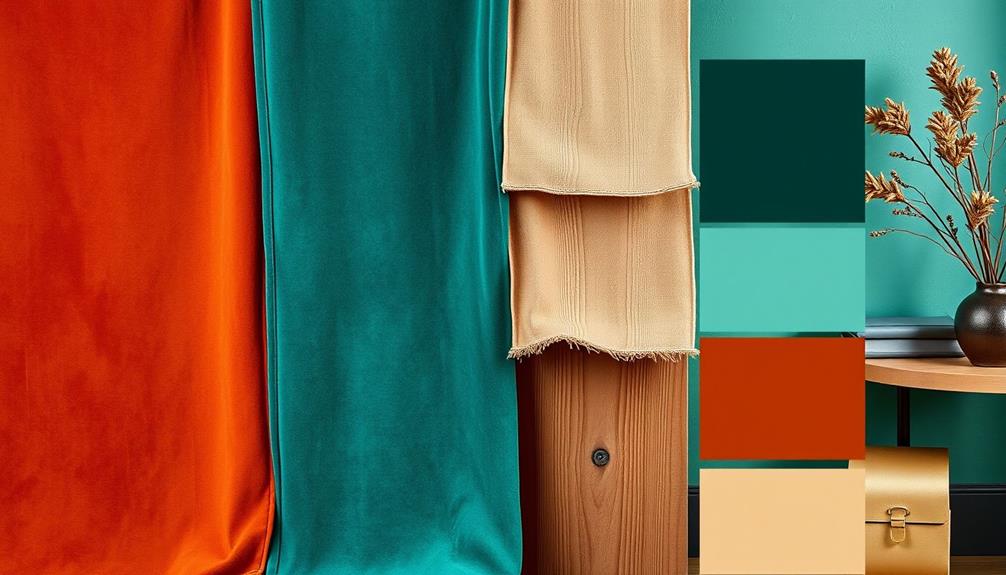
Color and texture are the dynamic duo that can transform a room from ordinary to extraordinary. Your color choices greatly impact the mood of your space. Warm tones like reds and yellows create coziness, while cool hues such as blues and greens foster tranquility.
To elevate your design, consider incorporating diverse textures that add depth and interest. Mixing materials—think soft fabrics, sleek metals, and natural woods—enhances both aesthetics and tactile experiences. For instance, using cozy teenage girl room colors can create a comfortable ambiance that reflects personal style.
To achieve a balanced design, remember the 60-30-10 rule:
- 60% of a dominant color
- 30% of a secondary color
- 10% of an accent color
Patterns can also complement your color choices and textures. Using patterned textiles or decor can infuse personality without overwhelming the overall design.
When selecting colors and textures, apply the principles of color theory; complementary colors create harmony, while contrasting textures introduce visual interest.
Seeking Professional Design Guidance
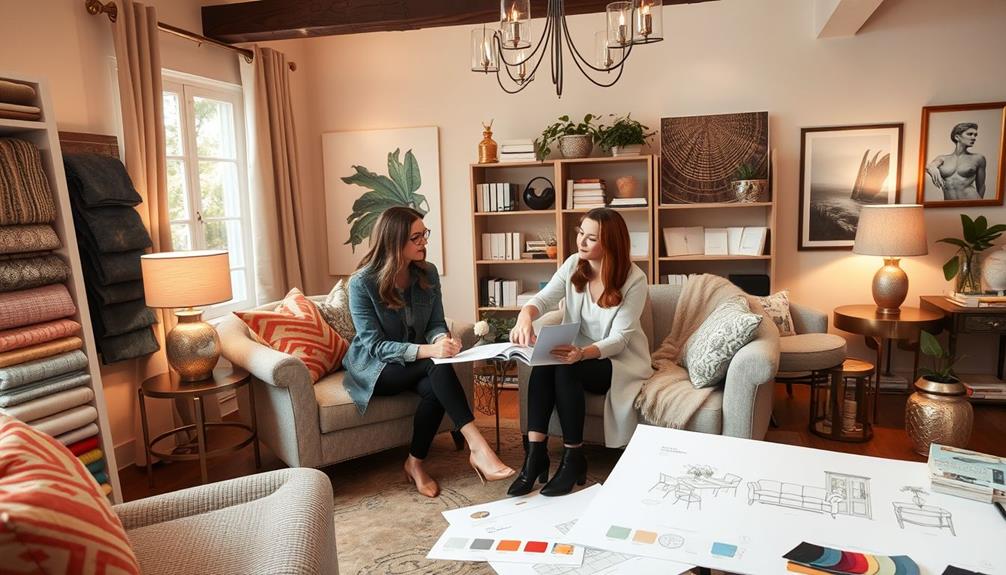
While you might feel overwhelmed by the multitude of design choices available, seeking professional design guidance can considerably simplify the process of defining your interior design style.
Professional designers not only help you identify your unique style but also refine it to create a cohesive look throughout your home. Additionally, if you're considering a minimalist approach, you might find inspiration in the Tiny House Movement, which emphasizes functional design and sustainability.
By taking a style quiz at Havenly, you'll be matched with designers who provide tailored advice based on your preferences and existing furniture.
These experts play an essential role in budget management, ensuring that your furniture selection aligns with both your aesthetic desires and financial constraints. They'll guide you through every step, helping you make informed decisions that maximize functionality and visual appeal in your space.
You'll also gain access to a wider range of furniture and decor options that you mightn't discover on your own, ensuring your home reflects your individuality.
Client testimonials consistently highlight the reduced stress and increased satisfaction when collaborating with professional designers, particularly during the often-daunting furniture selection process.
Reviewing Client Success Stories
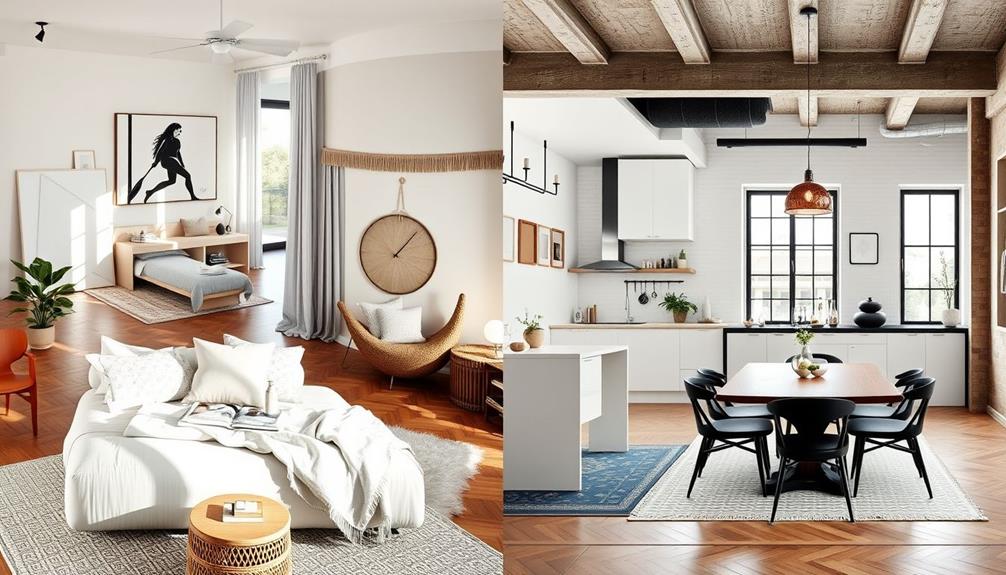
Client success stories reveal the transformative power of personalized design guidance. Through client testimonials, you can see how tailored support from Havenly designers has helped individuals discover and refine their unique interior design styles. Many clients, like Liz, experienced reduced stress during the furniture selection process, thanks to insights gained from the design quiz.
Here are some highlights from these inspiring stories:
- Seamless integration of various design elements, as shared by Pam, showcases how combining personal style with professional advice leads to harmony in your space.
- Clients appreciate the fun and collaborative nature of the design journey, making it an enjoyable experience rather than a chore.
- The blend of multiple design styles can create cohesive environments that truly reflect your personality and preferences.
- Positive feedback emphasizes the efficiency of identifying and embracing individual styles, resulting in successful home transformations.
These success stories illustrate the effectiveness of personalized design guidance. With the right support, you can commence your own journey to create a space that feels uniquely you, making your home a true reflection of your personal style.
Next Steps for Your Space
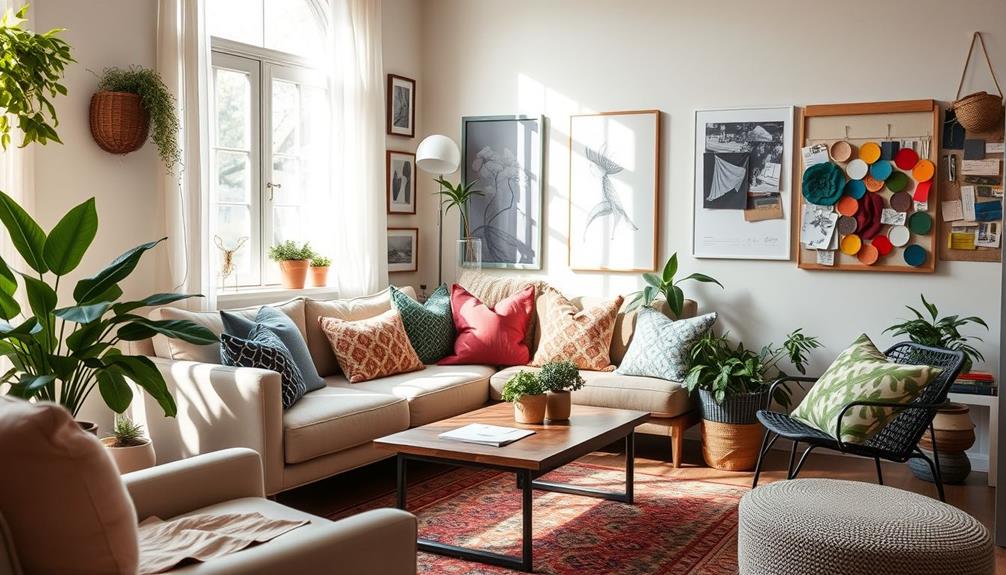
Having explored the inspiring journeys of clients who found their unique design styles, it's time to focus on the next steps for your own space.
Start by taking an online interior design style quiz; this can help you identify your unique preferences and provide tailored recommendations. Once you've got some insights, create a Pinterest board to collect and visualize decor inspirations that resonate with you. This will clarify your style direction.
Next, evaluate your current decor. Identify furniture pieces and decor items that evoke positive feelings and consider removing those that no longer align with your taste. This will help create a more cohesive environment.
Reflect on the desired atmosphere for your space by analyzing how colors, textures, and layouts impact your daily living and mood.
Conclusion
Now that you've explored your aesthetic preferences and analyzed various design trends, it's time to weave your unique style into your space. Imagine your home as a canvas, waiting for your personal brushstrokes of color, texture, and flair. Whether you blend styles or embrace a single theme, trust your instincts and let your personality shine through. With each choice, you're creating a haven that reflects who you are—your story brought to life in every corner.



